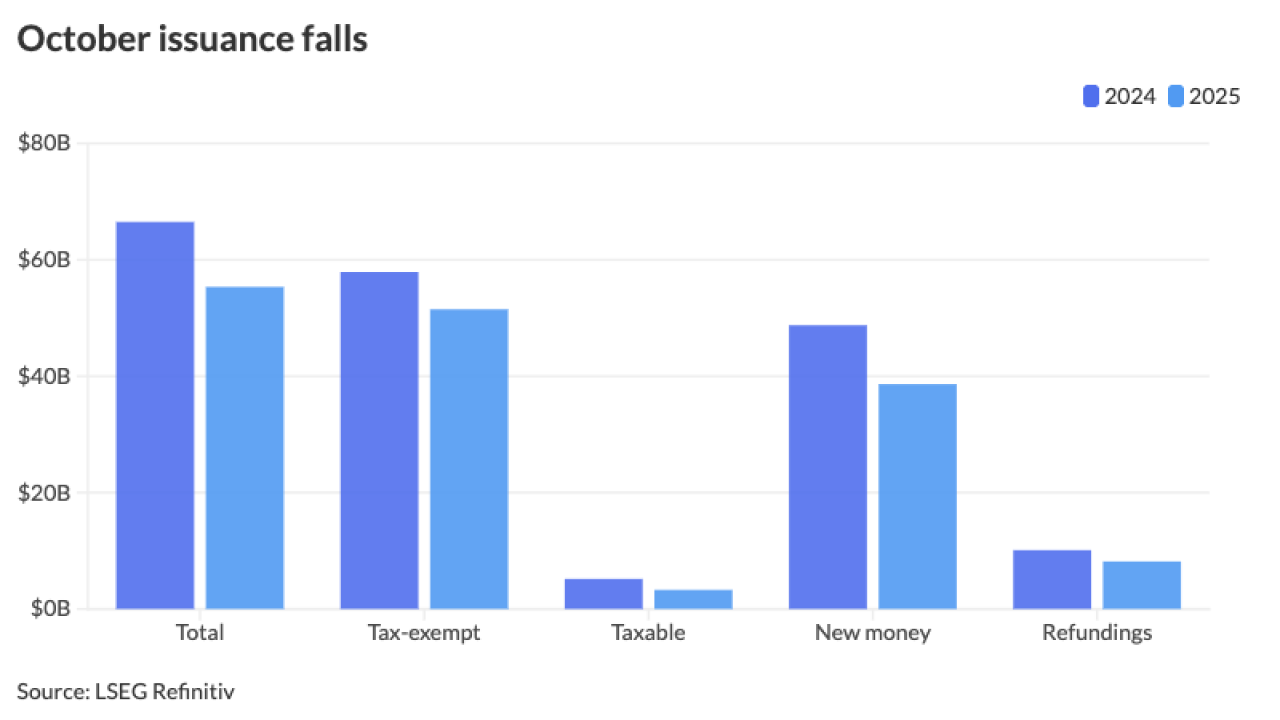
Municipal closed-end funds notched another stellar month in September as investors continued to flock to the sector’s fat tax-exempt yields.
The First Trust Advisors index tracking municipal closed-end funds vaulted 5.6% in September and is now up 37.8% for the year, far outperforming the Standard & Poor’s 500 Index.
The index is at its highest level since June 2008.
The municipal closed-end fund space, which according to the Closed-End Fund Association is made up of 262 funds, is on a roll.
A year ago, investors pummelled the sector for the double-whammy of leverage and exposure to sub-U.S. Treasury credit quality.
The First Advisors index plunged by a third in the second half of 2008.
Today both those factors are working in the funds’ favor. Many funds are paying little interest on their debt, providing a cheap source of financing to juice income and thus dividends to shareholders. And the underlying municipal bonds that populate the funds keep powering higher.
“While the downside was dramatic, the rebound has also been rather powerful,” Bank of America Merrill Lynch analyst Jon D. Maier wrote in a report last month. “Slowly but surely, muni CEFs as a group have regained much of what was lost in 2008.”
That is not true of many other types of closed-end funds, Maier said. Closed-end funds in other sectors were forced to unwind their leverage, selling their assets at low prices. Most municipal funds avoided that fate, he said.
A closed-end muni fund is created when an adviser sells stock representing ownership in the fund to the public. Much like a mutual fund or a unit investment trust, the adviser uses the money to buy a batch of municipal bonds and distribute the coupon payments as monthly dividends.
What distinguishes a closed-end fund is its ability to employ leverage. The cash raised from investors is typically supplemented by borrowed money, in the past usually through auction-rate securities and these days more often through tender-option bonds. The borrowed money is also plowed into munis.
Funds capture a spread between what they pay on the borrowed money and what they collect on municipal bonds. That difference is passed along to shareholders as enhanced dividends.
Much of the appeal of closed-end muni funds is the negligible cost of their leverage. Most municipal CEFs borrowed money through auction-rate securities, whose interest rates reset regularly at an auction.
When the auction fails, which began happening last year, funds pay a “penalty” rate tied to a short-term benchmark, such as the London Interbank Offered Rate.
With Libor a stone’s throw from zero, though, municipal closed-end funds are paying very low penalty rates on their debt. Nuveen Investments, the biggest name in municipal closed-end funds, is paying 0.5% on its auction-rate securities.
A typical 10-year triple-A bond, meanwhile, yields two percentage points more than that, according to the Municipal Market Data scale.
The result is closed-end fund dividends well north of the yields on municipal bonds.
The second-biggest closed-end muni fund by market value, Nuveen Insured Municipal Opportunity Fund, yields 5.75%, which assuming a 35% tax bracket is an 8.8% tax-equivalent yield.
The third-biggest fund, Eaton Vance Insured Municipal Bond Fund, sports a tax-equivalent yield of 10.3%.
Other than the biggest fund, which is not leveraged, the rest of the 10 biggest CEFs boast tax-equivalent yields of at least 9.3%.
Cecilia Gondor, executive vice president of Thomas J. Herzfeld Advisors, likes to buy closed-end funds when they trade at a steep discount to their assets.
Shares of closed-end funds trade on an exchange and sometimes become unmoored from their net asset value. Traditionally muni closed-end funds have traded at a discount of 4% to their assets.
In August the discounts were unusually low at little more than 2%. Gondor saw no reason to buy at such narrow discounts, and 92% of Thomas J. Herzfeld’s $424,000 muni closed-end fund portfolio was in cash.
The discount has since widened out to 3.9%. Gondor still thinks the sector is too expensive, but is prepared to become a little more acquisitive should the opportunity arise. She thinks the sector may become more attractive near the end of the year, when investors usually sell muni closed-end funds to lock in losses for tax purposes.
“There just isn’t much to buy out there,” she said. “We’re not bullish on the sector right now, but we do think there will be some opportunities in December.”
About 90% of the municipal portfolio is still in cash.
Stifel Nicolaus analyst Alex Reiss maintains “buy” ratings on some of the biggest funds, including the Nuveen Insured Municipal Opportunity Fund and the BlackRock MuniYield Insured Fund.
His preference in the muni space is for leveraged funds. He rates the four unleveraged funds he follows “hold.”
The leverage these funds use fueled income and means many funds will raise their dividends, according to Reiss.
“The leveraged municipal bond funds continue to offer closed-end fund investors the best combination of discounted asset values, a traditionally high-quality asset class, and solid earnings,” he wrote in his latest report.





